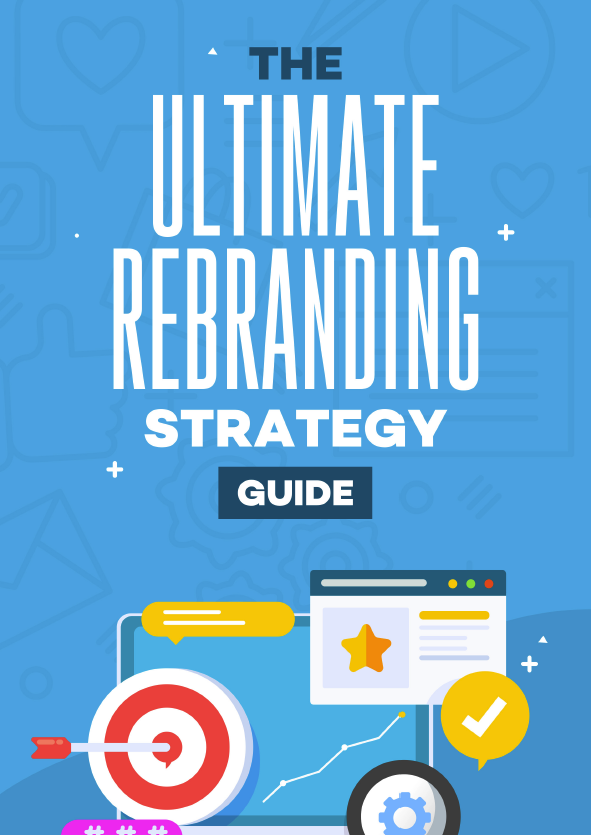“Did you guys see the IHOP rebrand?”
“Yeah. Super weird. They’re International House of Burgers now. How crazy is that?”
See that up there? ^
That’s “brand equity.”
It’s the intangible, intrinsic business value that comes from instant recognition and attention.
Mega-brands like Nike, Coca Cola, McDonald’s, and even IHOP (or should I say IHOB?) have it.
And we want it.
We want our brand, whether its a personal brand or one for our company or product to stand out and illicit strong feelings in a targeted group of super fans.
Some of us are even willing to chase that brand at the expense of actually running our business. We use it as a barrier.
That speaking engagement isn’t ‘on-brand’ for us.
That partnership won’t resonate with my target audience. I’m not gonna do it.
Brace yourself, because I’m here to tell you that’s the wrong view. You might not like to hear it, but it’s true.
A business can run successfully without an intentional effort to build strong brand (I’m looking at you, parts suppliers).
A brand in itself is not the ultimate goal.
Instead, a brand is a huge tool to help you get raving fans and loyal customers.
But to get the most benefit out of any tool, you have to know how to use it.
In this post, I’m going to walk you, step-by-step, through the process we use at Leverage when we want to help someone build a brand that pushes their business forward — instead of holding it back.
The Strategic Brand Development Process We’ve Used to Grow The Brands of New York Times Bestselling Authors
Whenever I write a comprehensive guide like this, I like to look through Google to read other posts on the topic.
And man, this topic has some really dull posts!
No offense to my colleagues, but branding is supposed to be the fun part of putting a company together. That’s why people spend so much time on it.
You have whole committees that are trying to determine the exact right color on a logo (#999957 or #99967?), because people enjoy it!
(Both of these are beige by the way. Really ugly beige. Just like most of these blog posts…)
So, let’s break it down in a way that doesn’t make you want to pull your eyes out, shall we?
I want to walk you through 4 questions about your favorite subject — yourself!
Before we get started…
…make sure you determine what “level” you’re thinking about when you’re discussing branding.
There are three:
- Company-wide
- Product line
- Product-specific branding
I won’t go into deep detail on that here, because I do it in my rebranding checklist post. So, check that out if you need some clarity on the topic.
For reference, I’m tackling company-wide branding in this post, but you can extrapolate these steps for any of the other branding efforts.
Step 1: Who Are You?

“A good name is greater than vast riches.”
Someone said that once. It can’t be original to me. Maybe the Bible?
Who knows.
Regardless, your good name is going to be a major resource to your company moving forward.
So, you need to determine who you are.
That’s important because transparency is no longer an option for companies —
It’s a requirement.
So, if you build a brand decision incongruent with who you are, or if you’re too ambitious with a branding decision of who you want to be —
Your customers and potential customers are going to see through you, like the kid saw through the emperor’s charade in the Emperor’s New Clothes.
(Do you ever think — “Where do these references come from?” I often do, and I truly have no idea on that one.)
Sit down and think about the things that are most important to you.
Are these core values of yours?
Is there a hypothetical situation where you may compromise on that point?
If not, you may have found something to hang your hat on.
Now, mold those core values into a mission statement for your company, like…
We exist to help XX customer do XX thing.
Once you’ve done that, go even further. Boil your mission statement down to one action word. Then, make sure that you share this constantly and consistently with your company.
You want your employees, contractors, family, friends, pets, stray cats, everyone around you, to be able to say your mission statement back to you.
For example:
Here at Leverage —
We exist to give renowned thought leaders and innovative companies the ability to reach as many people as they can with their message online.
Our one word purpose?
AMPLIFY.
This is an arduous process, and you’ll notice we haven’t made any decisions about logos, brand colors, or palettes.
That’s no accident.
Your mission statement and core values determine a heck of a lot more about who you are than a logo ever could.
So, take the time to get this right. It will be worth it.
Step 2: Who Listens to You?
Your doting spouse doesn’t count…
Here’s our goal in this step:
Determine the target audience for your message.
At Leverage, our target audience is message bearers and innovative companies.
For you, it may be washing machine manufacturers or people stuck in debt.
Avoid the urge to answer this question generally. It should be specific.
Instead of “business owners,” keep digging.
“Business owners in the service industry with a majority of employees under 30” might be hyper-specific, but it’s the direction you want to go.
Many times, the “who” is determined by the people themselves.
Specifically, you may put your message out there and find it attracts an audience you weren’t expecting.
Your job (and it’s a tough one) is to identify those people as specifically as you can.
There are many ways to do this. Here are 4 to get you started:
Facebook Analytics can give you powerful information about how Facebook users are interacting with your content.
That includes information like “where they live, how old they are, their gender, or even the device they use to access the internet most regularly.”
Your aim here isn’t to morph into a government surveillance drone. It’s to learn who your audience really is, so you can give them what they really need.
Whereas Facebook Analytics can only be used on Facebook (big surprise there, right?), you can use Google Analytics on your website to get information about the people who engage with your brand.
This includes both behavioral data, like which pages a user has visited.
And it also includes demographic data, like the age, gender, and interests of your audience, which Google calls “Affinity Categories.”
This one is crazy.
(Pun absolutely intended. I’m sorry.)
Crazy Egg can tell you which elements of your site people are paying attention to.
For example, Crazy Egg offers “snapshots” that provide heatmaps showing the highest areas of click activity.
It can even give you recordings of people scrolling through your site.
This is very valuable if you’re trying to sell a product using a long-form sales page. You can determine the exact spot where people stop scrolling — and change it, keeping them on the page longer and increasing the chance they’ll buy.
It’s easy to overcomplicate marketing. But, at its most basic level, it’s asking people about their problems and creating solutions to those problems.
Survey Monkey lets you create surveys you can send to your list to learn who they are, what problems they’re experiencing, and what they’d like to hear from you.
Step 3: Why Do They Listen?
Now that you’ve identified who is listening, you need to figure out why they’re listening to you.
What makes you unique?
How are you differentiated from competitors?
What pain point are you speaking to or solving that no one else in market answers the same way you do?
We usually accomplish this by asking questions like:
- “What is your #1 biggest problem when it comes X?”
- “How can my business help you solve that?”
- “If you had five minutes with me, what question would you ask?”
By reading the responses to these questions, you’re going to learn a TON about your target market.
Really. I can’t overstate the importance of this step.
Then, you can do another exercise called an “Empathy Map” to dive even deeper. (It’s not original to us, by the way.)
Basically, you want to think through what your ideal number one customer is hearing, seeing, thinking, and saying on a daily basis.
In other words:
What are the “inputs” that are giving you the “outputs” in the survey responses?
Once you do this, you’ll have a keen insight into what your brand should say, and how it can stand out with its messaging and visuals.
Step 4: What Do They Want Next?
This is the million-dollar step.
I repeat:
THIS IS THE MILLION-DOLLAR STEP.
What does your ideal customer want from you next?
When you know where you’re heading with your customer, you can begin to put the brand elements in place to lead them where they want to go.
Is your ideal customer a hard worker?
Maybe your brand imaging and messaging should connote blue-collar work in some way.
Is your ideal customer concerned with comfort?
Emphasize the ease of use of your company’s service or the luxury components of the product.
Simply put:
Use your brand’s elements to speak the customer’s language, so they can become the person they’ve always wanted to be.
The 3 Pillars of Our Branding Process

Our next step is to make sure we address the answer to each of those 4 questions in a meaningful and (more importantly) practical way.
1: Consistency
You know who your target customer is.
You know what they are seeing on a daily basis.
You know the messages, colors, images, sights, and sounds they’re inundated with.
You’ve asked about their biggest challenge and learned how they want your business to help.
And it’s time to use that research to your advantage.
You want to create a brand that stands out from the white noise. So, choose colors and a visual that does that.
Then, be consistent across all channels and places where your customer might see your branding.
Nike puts the swoosh on a golf ball.
Disney hides those mouse ears all over its resorts.
For the visual itself, brand equity is built not when people see the logo in odd and unexpected places, but when the logo in those applications still clearly communicates the brand’s core values and mission.
For example:
- Why Nike lives for the shot of the golf ball going in the cup to win the tournament (Check out 1:41)
- Disney stamps its carpets and pillows, so you’re transported to a magical place even when looking at a mundane detail.
When you start building a consistent identity, AND you deliver on your core values and mission statement at each step along the way, you’re creating a strategic brand that will engender loyalty and support from your target customer.
2: “Not Ugly”
People get too caught up in how pretty their logo is.
Our mantra:
“It can’t be ugly.”
You can’t let this element hold you up from launching a killer product your audience needs. Get a logo and color scheme that works, then move on.
Remember, the visual aspect of your brand is not static.
Over time, it can evolve and change to keep your audience’s attention and focus. (If you find yourself in need of a rebrand, follow this checklist.)
So, don’t worry about perfection.
Instead, worry about consistency that clearly communicates the mission, and then be meticulous about how that is delivered to your customers.
3: The Details!
How do you do this on a practical scale?
Details, y’all! Details!
It’s why Nordstrom always takes back returns.
It’s why Walmart has the big rollback signs throughout the store.
It’s why FedEx has an arrow in its logo.
It’s why Alexa let my kid order a Kindle the other day.
Nordstrom stands on customer service. Its customers expect to be treated with the ultimate respect. So, Nordstrom has instituted a no questions asked returns policy. They even accepted a returned set of tires.
Walmart competes on price. So, when you enter the store, you see huge rollback price signs. Even if you’re like me and don’t check the rollback prices against the competitors, you feel like they’ve done the research for you, because their brand consistently and blatantly reinforces their desire to compete on price.
FedEx wants to be the trusted source for your shipping needs. You may even remember the famous ad campaign: “When it absolutely, positively has to be there overnight.”
They hid an arrow in their logo to represent this speed and precision. A subliminal message that they will get your package from point A to point B.
Finally, Amazon is about ease-of-purchase. They introduced and patented the one-click ordering method. So, when the Amazon Echo came out, it’s no surprise you were able to order on command.
(Lucky for me — and much to the chagrin of my toddler and many other children out there, there are parental controls to prevent kids from purchasing…)
It’s these little details that allow companies to continue to stand apart.
The market gets more and more crowded each day. Everyone is competent. Everyone is pretty good.
But the details will make you great.
What does this look like for you?
Do you need to put extra effort into your website’s ease-of-use?
Do you need to provide a customer guarantee for your product?
Does your logo need a hidden gem?
Do you need to choose a trustworthy color for your logo or color palette?
I don’t have the answer, but you must!
Building a Great Brand Takes Time and Dedication
This isn’t going to be easy.
Your brand’s ability to separate itself is going to take all you’ve got. There’s a reason 90% of businesses fail.
For you to stand out, you need to put the time and effort into a branding process that will give you a head start.
If you need help along the way, feel free to contact us.
We’d be happy to help!

